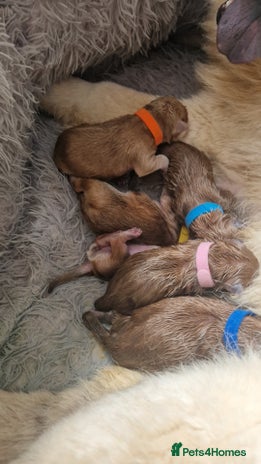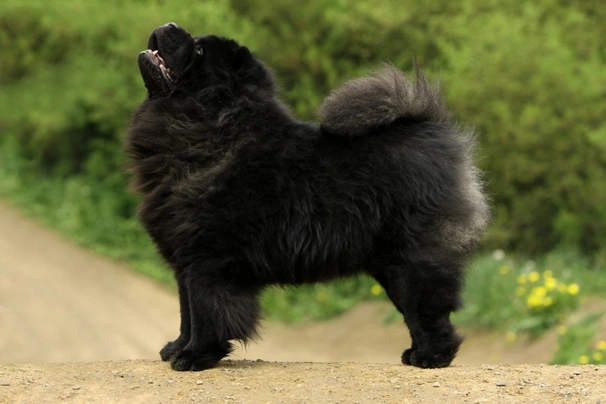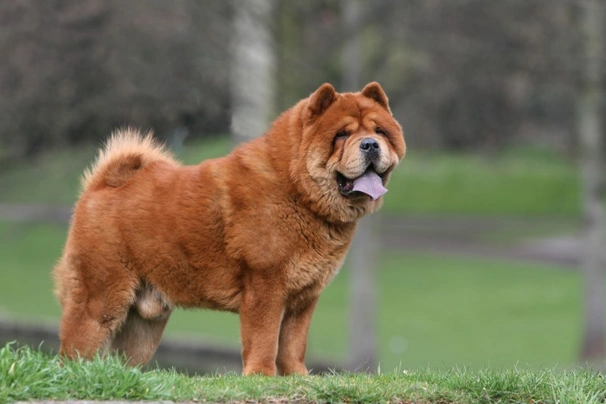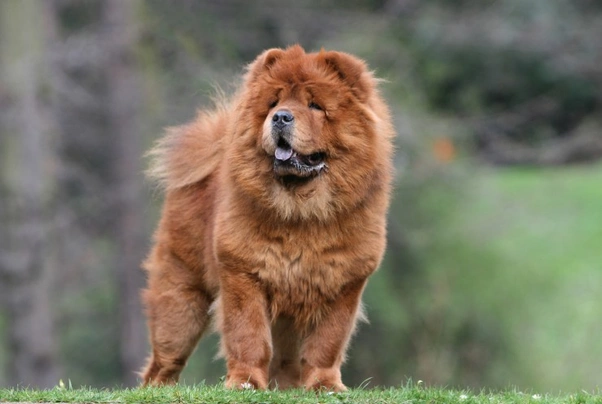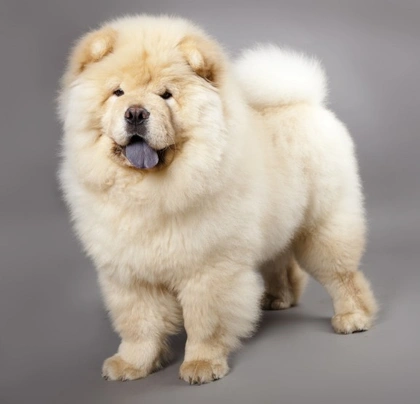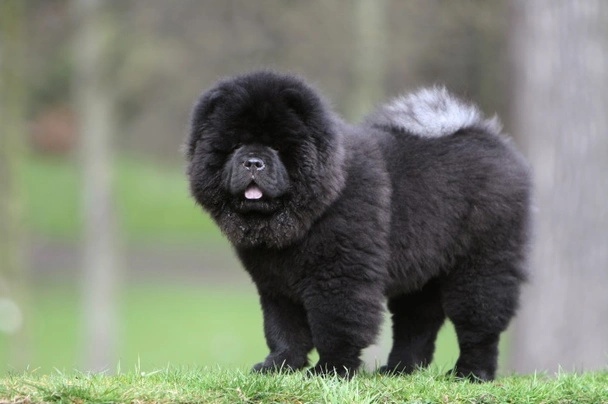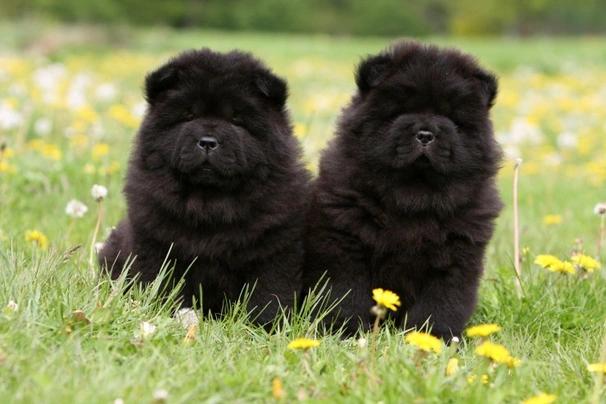Chow Chow
Pros
Cons
Introduction of the Chow Chow
One of the most distinguishing features about the Chow Chow is their blackish/blue tongue the other being their profuse thick coat. There are two types of Chow with the first being a smooth-coated dog and the other being the rough-coated Chow. Often aloof and a little stand-offish they are however extremely loyal and devoted to their owners and more especially to one person in a household who takes the most care of them.
Over the years the Chow Chow has become a popular choice with many people both here in the UK and elsewhere in the world all thanks to their unusual looks and their loyal natures. However they are not the best choice for first time owners because Chows need to be well trained and handled by people who are familiar with this type of dog or a Chow might just get the upper hand and start exhibiting a more dominant side to their nature.
History of the Chow Chow
Studies have should the Chow Chow was around in China back in the 11th Century BC when at the time they were described as dog with blue tongues that were heavily built harsh coats and straight hind legs. With this said some breed enthusiasts believe the breed did not originate China at all and that it was the Monguls who introduced them to the country when they invaded China some 3000 years ago. It was only later that the Chow founds its way to the monasteries of Tibet where interestingly some monasteries still breed blue Chow Chows.
With this said some people believe it was the Tartars who bought dogs that looked like lions and which had black tongues back from China thousands of years before the birth of Christ. There is also a lot of evidence of Chows in pottery and sculptures of the Chinese Han Dynasty (206 BC to 22 AD).
There is some evidence of very similar dogs existing in the Arctic Circle where they were taken through Mongolia and Siberia to finally arrive in China. It is thought that breeds like the Samoyed Norwegian Elkhound Keeshond and the Pomeranian are in the Chow's ancestors. There is some evidence of a Chinese Emperor owning around two thousand Chow type dogs in the 7th century AD which he used as hunting dogs too.
The breed has always been thought of as a "hunting" dog and was used to track down larger prey like wolves and leopards. As far back as the seventh Century BC the Chow was not only used to hunt but to guard and herd livestock too. Chows also boast superb tracking skills and are still used in China for this purpose. During the winter months these powerful strong-willed dogs were also used to pull sleds. Chows were and are still highly prized in China for their fur and many were reared just for this purpose. Their meat is also still considered a delicacy in remote parts of the country.
It was not only the 18th Century that the Chow first appeared in Europe when dogs were brought back from China on clipper ships although beforehand the breed had remained a bit of a mystery to the rest of the world for a long time because China had closed its borders right up until the 1800s. The Chow did not appear in the UK until quite a bit later when a few dogs were kept at the London Zoological Gardens. Queen Victoria received a Chow Chow as a gift in 1865. However it was the Marchioness of Huntley who really promoted the breed in the UK during the late 1800's and it was Lady Faudel Philips who was to become the leading breeder as well as exhibitor right up until the end of the 1800's. It was in 1895 that the Chow Chow Club was founded in the UK.
In more recent times Chow Chows have become popular pets with movie stars during the "roaring twenties" and today they remain high on the list of preferred companion dogs with people the world over including here in the UK.
Interesting facts about the breed
- Is the Chow Chow a vulnerable breed? No they are one of the most popular breeds in the UK and elsewhere in the world
- Queen Victoria received a Chow Chow as a gift in 1865
- The Chow is the only other dog other than the Shar Pei to have a blue tongue
- It is thought that the emperor of China in the 7th Century owned 2500 Chow dogs that he used for hunting
Appearance of the Chow Chow
Height at the withers: Males 43 - 51 cm Females 43 - 51 cm
Average weight: Males 25 - 32 kg Females 20 - 27 kg
The Chow is a large dog that boasts some unique physical traits one of which is the fact they have blackish/blue tongues and the other being they have very thick dense coats. They have large heads that does not have a very noticeable stop their muzzle is moderately long and their nose is wide and large being black in colour except dogs that boast near white or cream coats where their noses are much lighter. Chows with a fawn or blue coat should have black noses but self-coloured is allowed as a breed standard.
Their eyes are oval shaped and dark but dogs with blue or fawn coats have eyes that match their colouring. A Chow Chow's ears are small slightly rounded at the tips and very thick. Dogs carry them upright and they are set wide apart on their head tilting forward over their eyes. The way a Chow's ears stand up on a dog's head gives them the appearance of always scowling which is another unique physical trait that makes these dogs stand out in a crowd.
They have strong mouths with a perfect scissor bite where their upper teeth neatly overlap their lower ones. They have bluish/black tongues and in fawn or blue coated dogs their gums tend to be various lighter shades with cream and white dogs having the lightest coloured gums of them all. Chows have very strong necks which they hold slightly arched giving them their proud and aloof look.
Their shoulders are well developed muscular and sloping with dogs boasting straight front legs with lots of bone. Chows are deep chested dogs that have a well sprung ribcage powerful loins and a strong level back. Their hindquarters are powerful with well-muscled first and second thighs. They have very cat-like feet being small and round with dogs standing well up on their toes. A Chow's tail is set high which dogs carry them well over their backs.
When it comes to their coat Chow Chows can either have smooth or rough coats which are as follows:
Rough-coated dogs have thick dense straight hair that stands well off from their body. Their outer coat is coarse but their undercoat is woolly and much softer. Dogs have much thicker hair around their necks which forms a lion-like mane and they boast breeches on the back of their thighs which adds to their overall appeal and impressive good looks.
Smooth-coated dogs have a shorter double coat with dense straight hair that stands upright and which is very plush to the touch.
The accepted colours for Kennel Club registration for the Chow are as follows:
- Black
- Blue
- Cream
- Fawn
- Red
- Self-red
- Shaded Red
- White
Gait/movement
When Chow Chows move they have quite a short stride and their back feet do not come very high off the ground so it looks like a dog is skimming it. The result gives the impression of a pendulum-like gait when a dog is seen in profile. Their front and back legs move in parallel motion remaining very straight when they move.
Faults
The Kennel Club frowns on any exaggerations or departures from the Chow breed profile and would judge any faults on how much they affect a dog's overall health and well-being as well as their ability to perform.
Male Chows should have both testicles fully descended into their scrotums and it is worth noting that some Chow Chows can be a little taller or shorter as well as slightly heavier or lighter than set out in their Kennel Club breed standard which is given as a guideline only.
Temperament of the Chow Chow
Chow Chows are known to be loyal aloof and dignified dogs that are quite independent by nature. They are often described as being more cat-like than dog and although some people say they form a strong tie with just one person in a household which is typically the person who takes the most care of them they a form strong bonds with the entire family too. They are generally wary of strangers and people they don't know but with time and patience and once they get to know someone they accept being around them with no trouble at all.
Chows are very intelligent dogs but they can be strong-willed when the mood takes them too. Their training and socialisation must start early for them to become well-rounded obedient characters. They are known to have a stubborn streak and if allowed they will show a more dominant side to their character which is something to be avoided at all costs. They need to be given the right sort of direction from a young age and then throughout their lives so they understand their place in the pack and who is alpha dog in a household.
With this said Chows form very strong bonds with one person although they are always affectionate and friendly towards everyone in a household. They are not a good choice for first time owners because they need to be handled and trained correctly by someone who is familiar with this type of strong-willed intelligent dog. They are not a good choice for people who cannot give their dogs the time they need to be well-rounded characters. Because they form such a strong bond with one owner the Chow can suffer from separation anxiety which can be a real problem for people who spend all day out at work leaving their dogs on their own for long periods of time.
Chows are instinctively suspicious of strangers and people they don't know they also tend to be very protective of their family and their property which means they are very quick to let an owner know when strangers are about. They are however very good around children as long as they have grown up with them making Chows a good choice for families who are familiar with this type of intelligent dog and who know how to handle them.
It's in a Chow's nature to chase anything that moves which means great care has to be taken when walking a dog through the countryside or park where livestock may be around. The one thing Chows are not keen on chasing is anything an owner throws for them which is something these dogs are not interesting in doing whatsoever.
Are they a good choice for first time owners?
Chows are not the best choice for first time dog owners because they are better suited to people who are familiar with their specific needs. Chows grow up to be powerful strong minded adult dogs and their handling and training must start early and it must be consistent throughout a dog's life so they understand their place in the pack and just what is expected of them.
What about prey drive?
Chows are renowned for their hunting skills even in a domestic environment and therefore boast having an extremely high prey drive. As such care should always be taken when walking a Chow off the lead anywhere near livestock or wild animals just in case they decide to give chase.
What about playfulness?
Chows are playful in their own special way it just takes them longer to respond to things. Throwing a toy for a Chow to retrieve would be a pointless exercise because most dogs would just look at their owners with a look of "you threw you go and get it".
What about adaptability?
Chows are better suited to people who have secure back gardens where dogs can roam whenever possible and where they can express themselves as they should. As such a Chow is not that adaptable to apartment living and best suited to living in a house with garden either in the town or country.
What about separation anxiety?
Chows form strong ties with their families and are never very happy when left on their own for any great length of time which often sees these dogs suffering from separation anxiety. As such they are better suited to households where one person usually stays at home when everyone else is out so they are never left on their own for too long which could see a dog being destructive around the home as they way of relieving their stress.
What about excessive barking?
A Chow will only bark when necessary and they are not known to be "barkers" just for the sake of it. They are always quick to let an owner know when someone is around and when they don’t like something that’s going on in their environment.
Do Chows like water?
Most Chows are not particularly fond of water with some dogs not even liking to get their feet wet or go out for a walk when it is raining. The fact they have such heavy dense coats means that when a Chow gets wet or goes in the water the weight of their coat alone might just pull them down. As such care should always be taken when walking a Chow off the lead anywhere near more dangerous watercourses just in case a dog falls in and needs rescuing.
Are Chows good watchdogs?
Chows are excellent watchdogs which is something that is deeply embedded in their psyche having been bred to guard for centuries.
Intelligence / Trainability of the Chow Chow
The Chow is an intelligent dog but they do have a stubborn streak in them which means without the right sort of handling and training these dogs can be hard to train. However in the right hands and given the right sort of direction the Chow is relatively easy when it comes to teaching them the rules and how to behave. The thing to bear in mind is that Chows need to know why they are doing something and will not do anything they think is not necessary as such a lot of patience and understanding is needed when handling and managing a Chow.
Because the breed is known to be extremely clean Chows are easy to housetrain but again without the right sort of handling and enough early socialisation these dogs can become unmanageable which is why they are not the best choice for first time owners and why they are better suited to people who understand their needs and have the time to dedicate to a loyal intelligent albeit sometimes stubborn canine companion.
Chow puppies must be taught the ground rules right from the word go so they understand what their owners expect of them. The first commands a puppy should be taught are as follows:
- Come
- Sit
- Stay
- Quiet
- Leave it
- Down
- Bed
Children and other
The Chow is known to be good around children although they do tend to become very protective of them. With this said they are large dogs and therefore any interaction between the kids and a dog should always be well supervised by an adult to make sure things stay calm and no children get knocked over albeit accidentally. The other thing to bear in mind is that Chows can be a little snappy if they feel threatened or provoked which can happen when children get too boisterous around them.
Care needs to be taken when a Chow meets any dogs they don't already know and the same can be said of any pets in a household. Although they are rarely the ones to start a fight a Chow will think nothing of defending themselves if they feel threatened by another dog in any way.
Health of the Chow Chow
The average life expectancy of a Chow Chow is between 9 to 15 years when properly cared for and fed an appropriate good quality diet to suit their ages.
Like many other pedigree dogs they are known to suffer from certain hereditary conditions which are worth knowing about if you are hoping to share your home with one of these large and lovely looking dogs. The health issues that seem to affect the breed the most include the following:
- Entropion and other eye issues - test available through BVA
- Eczema/hot spots
- Bloat
- Cruciate ligament - rupture
- Hypothyroidism
- Addison's disease
- Cushing's disease
- Exocrine pancreatic insufficiency (E.P.I)
- Phemghigus foliaceus (PF)
- VHK-like syndrome or Uveo Dermatological UV syndrome
- Breathing issues
- Hip Dysplasia – BVA test available
- Elbow Dysplasia - BVA test available
- Heatstroke
- Alopecia X
More about Alopecia X
Many Nordic breeds suffer from Alopecia X but Chow Chows too can be affected and its condition that generally affects young adult dogs between the ages of 1 to 3 years old. However some puppies as young as 9 months old can be affected and older Chows when they reach they senior years can suffer from Alopecia X too with intact males being the most susceptible.
Studies suggest there could be a genetic predisposition why some Chows are affected which could be due to an abnormal hormone that affects a dog's hair follicles.
More about Exocrine pancreatic insufficiency (EPI)
When dogs suffer from exocrine pancreatic insufficiency (EPI) it's because they cannot produce enough digestive enzymes which results in them not being able to absorb or digest much needed nutrients. When too much undigested food builds up in a dog's small intestine the result is an overgrowth of bacteria and this in turn makes matters worse as it negatively impacts the intestinal process.
The pancreas can take quite a lot and will only give up when over 90% of its function is negatively impacted. The causes are as follows:
- Acinar atrophy
- Chronic pancreatic hypoplasia
- Neoplasia
More about Phemphigus foliaceus (PF)
Phemphigus foliaceus or PF is an autoimmune skin disorder where a dog's own immune system attacks links found between cells in the skin and this results in blisters forming which then become pus-filled before eventually crusting over. The Chow is predisposed to suffering from the condition and early diagnosis and treatment are essential to prevent a condition from getting any worse.
More about UveoDermatological Syndrome
Chows like a lot of Nordic breeds can suffer from UveoDermatological syndrome. When dogs first develop the condition it often goes unnoticed but gradually a depigmentation around a dog's nose and eyelid occurs which can lead to them suffering from conjunctivitis. In severe cases a dog's retina can become detached which is a very painful condition. Young dogs when they are around 13 months old can develop the condition although when a Chow is 6 years old they can also suffer from UveoDermatological syndrome too. Occasionally puppies can develop the condition too.
What about vaccinations?
Chow puppies would have been given their first vaccinations before they are sold but it is up to their new owners to ensure they have their follow-up shots on time with the vaccination schedule for puppies being as follows:
- 10 -12 weeks old bearing in mind that a puppy would not have full protection straight away but would be fully protected 2 weeks after they have had their second vaccination
There has been a lot of discussion about the need for dogs to have boosters. As such it's best to talk to a vet before making a final decision on whether a dog should continue to have annual vaccinations which are known as boosters.
What about spaying and neutering?
A lot of vets these days prefer to wait until dogs are a little older and therefore more mature before neutering or spaying them. As such they recommend waiting until dogs are between the ages of 6 to 9 months old before they undergo the procedures. With this said other vets recommend spaying and neutering dogs when they are 6 months old but never any earlier unless it is for medical reasons.
What about obesity problems?
Chows are known to like their food and are therefore prone to put on too much weight if they are not fed correctly or given enough daily physical exercise. Some dogs can put on weight once they have been spayed or neutered and older Chows are more at risk of gaining too much weight too. As such it is very important to keep an eye on a dog's waistline and to adjust their calorie intake accordingly to prevent this from happening. Obesity can shorten a dog's life by several years because of the extra strain it puts on a dog's heart and other vital internal organs.
What about allergies?
As previously mentioned Chows are prone to suffering from specific health issues that affect their skin and it's important to catch a problem early before it turns into something nastier and therefore harder to treat. There are specific things that can also trigger an allergy which includes the following:
- Environment
- Certain foods
- Fleas ticks and other parasites
- Seasonal pollens
- Dust mites
- Mould
Participating in health schemes
Responsible breeders would always ensure that all the dogs they use in a breeding programme are tested for known hereditary and congenital health issues that are known to affect the breed. This includes using the following schemes before a dog is used for breeding purposes:
- BVA/KC Hip Dysplasia Scheme
- BVA Eye Scheme
- BVA/KC Elbow Dysplasia Scheme
- Chow Chow Breed Council Bronze Health Assessment
What about breed specific breeding restrictions?
Chows have two coat types being the rough and the smooth. There is an option to choose "smooth coat" when registering puppies. If the option is not selected puppies will be registered as being "rough-coated".
What about Assured Breeder Requirements?
The Kennel Club strongly advise that all breeders including non-registered Assured Breeders use the following schemes on all their stud dogs:
- BVA/KC Hip Dysplasia Scheme
- BVA/KC Elbow Dysplasia Scheme
- Eye testing
- Chow Chow Breed Council Bronze Health Assessment
Caring for the Chow Chow
As with any other breed Chows need to be groomed on a regular basis to make sure their coats and skin are kept in top condition bearing in mind that the breed is known to suffer from several health issues that affect their skin. They also need to be given regular daily exercise to ensure they remain fit and healthy. On top of this they need to be fed good quality food that meets all their nutritional needs throughout their lives.
Caring for an Chow puppy
Chow puppies can be boisterous during playtime which means it's essential for homes and gardens to be puppy-proofed well in advance of their arrival. A responsible breeder would have socialised their puppies right from the word go which always leads to more outgoing confident and friendly dogs. With this said any puppy is going to feel vulnerable when they leave their mother and littermates which must be taken into account when they arrive in a new home. The longer a puppy can remain with their mother and the rest of their littermates the better although it should never be for too long either.
It's best to pick puppy up when people in the home are going to be around for the first week or so which is the time that's generally needed for a puppy to settle in. Puppy-proofing the home and garden means putting away any tools and other implements that a boisterous puppy might injure themselves on. Electric wires and cables must be put out of their reach because puppies love chewing on things. Toxic plants should be removed from flowerbeds and the home too.
Puppies need to sleep a lot to grow and develop as they should which means setting up a quiet area that's not too out of the way means they can retreat to it when they want to nap and it's important not to disturb them when they are sleeping. It's also a good idea to keep "playtime" nice and calm inside the house and to have a more active "playtime" outside in the garden which means puppies quickly learn to be less boisterous when they are inside.
Chows are very clean dogs by nature which helps when it comes to housetraining a puppy. By limiting the amount of space they can roam helps limit the number of accidents a puppy might have around the home but it's important to keep an eye on when they need to go to the toilet and to let them outside or put them a puppy training pad as quickly and as calmly as possible always remembering to praise a puppy when they get it right. Puppies should never be told off for having an "accident" because it would do more harm than good.
The documentation a breeder provides for a puppy must have all the details of their worming date and the product used as well as the information relating to their microchip. It is essential for puppies to be wormed again keeping to a schedule which is as follows:
- Puppies should be wormed at 6 months old
- They need to be wormed again when they are 8 months old
- Puppies should be wormed when they are 10 months old
- They need to be wormed when they are 12 months old
Things you'll need for your puppy
There are certain items that new owners need to already have in the home prior to bringing a new puppy home. It's often a good idea to restrict how much space a puppy plays in more especially when you can't keep an eye on what they get up to bearing in mind that puppies are often quite boisterous which means investing in puppy gates or a large enough playpen that allows a Chow puppy the room to express themselves while keeping them safe too. The items needed are therefore as follows:
- Good quality puppy or baby gates to fit on doors
- A good well-made playpen that's large enough for a Chow puppy to play in so they can really express themselves as puppies like to do
- Lots of well-made toys which must include good quality chews suitable for puppies to gnaw on bearing in mind that a puppy will start teething anything from when they are 3 to 8 months old
- Good quality feed and water bowls which ideally should be ceramic rather than plastic or metal
- A grooming glove
- A slicker brush or soft bristle brush
- Dog specific toothpaste and a toothbrush
- Scissors with rounded ends
- Nail clippers
- Puppy shampoo and conditioner which must be specifically formulated for use on dogs
- A well-made rolled dog collar or harness
- A couple of strong dog leads
- A well-made dog bed that's not too small or too big
- A well-made dog crate for use in the car and in the home that's large enough for a Chow puppy to move around in
- Baby blankets to put in your Chow's crate and in their beds for when they want to nap or go to sleep at night
Keeping the noise down
All puppies are sensitive to noise including Chow puppies. It's important to keep the noise levels down when a new puppy arrives in the home. TVs and music should not be played too loud which could end up stressing a small puppy out.
Keeping vet appointments
As previously mentioned puppies would have had their first vaccinations before they are sold and it's important for them to have their follow-up shots on time with the schedule being as follows:
- 10 -12 weeks old bearing in mind that a puppy would not have full protection straight away but would only be fully protected 2 weeks after they have had their second vaccination
When it comes to boosters it's best to discuss these with a vet because there is a lot of debate about whether a dog really needs them after a certain time. However if a dog ever needed to go into kennels their vaccinations would need to be
What about older Chows when they reach their senior years?
Chows need lots of special care because as they reach their golden years they are more at risk of developing certain health concerns. Physically a Chow will start to have a greying muzzle but there will be other noticeable changes too which includes the following:
- Coats become coarser
- A loss of muscle tone
- Chows can either become overweight or underweight
- They have reduced strength and stamina
- Older dogs have difficulty regulating their body temperature
- They often develop arthritis
- Immune systems do not work as efficiently as they once did which means dogs are more susceptible to infections
- Older dogs change mentally too which means their response time tends to be slower as such they develop the following:
- They respond less to external stimuli due to impaired vision or hearing
- They tend to be a little pickier about their food
- They have a lower pain threshold
- Become intolerant of any change
- Often an older dog can feel disorientated
Living with a Chow in their golden years means taking on a few more responsibilities but these are easily managed and should include taking a look at their diet the amount of exercise they are given how often their dog beds need changing and keeping an eye on the condition of their teeth.
Older Chows need to be fed a good quality diet that meets their needs at this stage of their lives all the while keeping a close eye on a dog's weight because as previously touched upon sometimes older dogs can gain too much weight or they might go the other way and loose too much as well. A rough feeding guide for older Chows is as follows bearing in mind they should be fed highly digestible food that does not contain any additives:
- Protein content should be anything from 14 – 21%
- Fat content should be less than 10%
- Fibre content should be less than 4%
- Calcium content should be 0.5 – 0.8%
- Phosphorous content should be 0.4 – 0.7%
- Sodium content should be 0.2 – 0.4%
Older Chows don't need to be given the same amount of daily exercise as a younger dog but they still need the right amount of physical activity to maintain muscle tone and to prevent a dog from putting on too much weight. All dogs need access to fresh clean water and this is especially true of older dogs when they reach their golden years because they are more at risk of developing kidney disorders.
Grooming of the Chow Chow
Chows enjoy being groomed because they like the one-to-one attention they are given when they are being pampered and brushed. It's important for puppies to be groomed from a young age paying particular attention to touching their feet and their ears. This makes it that much easier to check them later when these dogs are larger and that much heavier to handle.
It's also important to regularly check a Chow's chest because when they get excited some of them tend to dribble and this can cause problems with the skin becoming sore and inflamed if not regularly cleaned and wiped dry. Ideally Chows need to be groomed at least once a week and then daily when they shed more hair which like other dogs tends to be during the Spring and then again in the Autumn.
One thing to bear in mind is that Chows should never be placed in a "drying box" that professional groomers use to dry dogs off after they’ve been given a bath. The reason being that these dogs can quickly overheat and they run the risk of doing just this when they are put in a drier. When dogs overheat they can collapse and in a worst-case scenario it could prove fatal.
Exercise of the Chow Chow
Chows are not known to be high energy dogs but they do need to be given the right amount of daily exercise which includes a lot of mental stimulation for them to be truly happy dogs. They need around 40 to 60 minutes exercise every day and they enjoy being out and about in the great outdoors although Chows really like being able to wander around a back garden too. With this said the fencing in a garden needs to be very secure or you may find a Chow will find their way out and go off exploring which could land them into all sorts of trouble.
Because of their heavy coats Chows can overheat very quickly in hot weather. It’s important for them to be kept inside during the hotter summer months and to only take them for a walk first thing in the morning and then once the sun has gone down in the evening when the temperature tends to be a lot cooler.
With this said young puppies should not be given too much exercise because their joints and bones are still growing and too much pressure on them could result in a dog developing joint problems later in their lives.
Feeding of the Chow Chow
If you get a Chow puppy from a breeder they would give you a feeding schedule and it's important to stick to the same routine feeding the same puppy food to avoid any tummy upsets. You can change a puppy's diet but this needs to be done very gradually always making sure they don't develop any digestive upsets and if they do it's best to put them back on their original diet and to discuss things with the vet before attempting to change it again.
Young Chows when they reach 6 months old can quite safely be put on two meals a day but before this they need to be fed between 3 to 4 times a day and ideally when they are three months old they should already be on just three meals a day.
Older dogs are not known to be fussy or finicky eaters but this does not mean you can feed them a lower quality diet. It's best to feed a mature dog twice a day once in the morning and then again in the evening making sure it's good quality food that meets all their nutritional requirements. It's also important that dogs be given the right amount of exercise so they burn off any excess calories or they might gain too much weight which can lead to all sorts of health issues. Obesity can shorten a dog's life by several years so it's important to keep an eye on their waistline from the word go.
Because Chows are deep chested dogs they are prone to suffer from bloat and as such they should never be fed just before they go out for a walk or when they have just come back from one. They should also be fed twice a day rather than just once a day for the same reason.
Feeding guide for a Chow puppy
Puppies need to be fed a highly nutritious good quality diet for them to develop and grow as they should. As a rough guide a Chow puppy can be fed the following amounts every day making sure their meals are evenly spread out throughout the day and it's best to feed them 3 or 4 times a day:
- 2 months old - 214g to 238g depending on puppy's build
- 3 months old - 256g to 292g depending on puppy's build
- 4 months old - 275g to 318g depending on puppy's build
- 5 months old - 281g to 339g depending on puppy's build
- 6 months old - 281g to 361g depending on puppy's build
- 8 months old - 244g to 325g depending on puppy's build
- 10 months old - 202g to 261g depending on puppy's build
- 11 months old - 202g to 261g depending on puppy's build
- Once a puppy is 12 months old they can be fed adult dog food.
Feeding guide for an adult Chow
Once fully mature an adult Chow must be fed a good quality diet to ensure their continued good health. As a rough guide an adult Chow can be fed the following amounts every day:
- Dogs weighing 20 kg can be fed 233g to 307g depending on activity
- Dogs weighing 25 kg can be fed 275g to 362g depending on activity
- Dogs weighing 27 kg can be fed 292g to 371g depending on activity
- Dogs weighing 30 kg can be fed 305g to 381g depending on activity
Chow Chow price
If you are looking to buy a Chow you would need to pay anything from £800 to over £950 for a well-bred pedigree puppy. The cost of insuring a male 3-year-old Chow Chow in northern England would be £48.65 a month for basic cover but for a lifetime policy this would set you back £156.54 a month (quote as of September 2017). When insurance companies calculate a pet's premium they factor in several things which includes where you live in the UK and a dog's age and whether they have been neutered or spayed.
When it comes to food costs you need to buy the best quality food whether wet or dry to feed your dog throughout their lives making sure it suits the different stages of their lives. This would set you back between £40 - £60 a month. On top of this you would need to factor in veterinary costs if you want to share your home with a Chow and this includes their initial vaccinations their annual boosters the cost of neutering or spaying your dog when the time is right and their yearly health checks all of which quickly adds up to over a £1000 a year.
As a rough guide the average cost to keep and care for a Chow Chow would be between £100 to £180 a month depending on the level of insurance cover you opt to buy for your dog but this does not include the initial cost of buying a well-bred Kennel Club registered pedigree puppy.
Buying advice
When visiting and buying any puppy or dog there are many important things to consider and questions to ask of the breeder/seller. You can read our generic puppy/dog advice here which includes making sure you see the puppy with its mother and to verify that the dog has been wormed and microchipped.
Chows are an extremely popular breed both in the UK and elsewhere in the world which means that well-bred puppies command a lot of money. As such with Chows there is specific advice questions and protocols to follow when buying a puppy which are as follows:
- Beware of online scams and how to avoid them. You may see online and other adverts by scammers showing images of beautiful Chow Chowpuppies for sale at very low prices. However the sellers ask buyers for money up front before agreeing to deliver a puppy to a new home. Potential buyers should never buy a puppy unseen and should never pay a deposit or any other money online to a seller. You should always visit the pet at the sellers home to confirm they are genuine and make a note of their address.
- As previously touched upon Chows are among the most popular breeds in the UK. As such there are many amateur breeders/people who breed from Chows far too often so they can make a quick profit without caring for the welfare of the puppies their dam or the breed in general. Under Kennel Club rules a dam can only produce 4 litters and she must be between a certain age to do so. Anyone wishing to buy a Chow puppy should think very carefully about who they purchase their puppy from and should always ask to see the relevant paperwork pertaining to a puppy's lineage their vaccinations and their microchipping
- Responsible breeders now work closely with the Kennel Club not only to ensure good breeding practices are maintained but also as a way of controlling the price of a Chow Chow puppy. Prospective buyers as such should always establish they are paying the correct amount of money for a well-bred Chow Chow puppy

Smooth and rough KC Chow chow pups
£1,750
3 Chow Chow Puppies - Polar white/Cream
£1,350